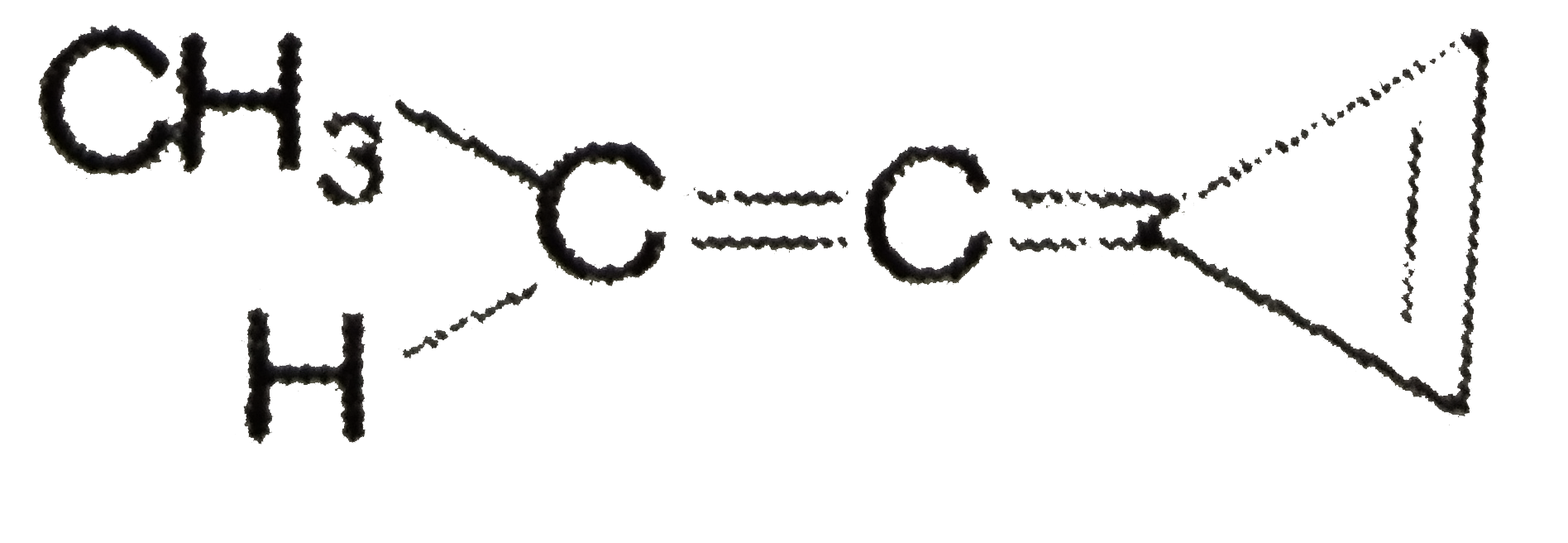X is




The correct Answer is:A
To solve the problem, we need to identify the compound X that, when treated with ozone (O3) followed by zinc (Zn) and water (H2O), yields carbon dioxide (CO2), a ketone, and an aldehyde.
1. Understanding Ozonolysis:
- Ozonolysis is a reaction where alkenes or alkynes react with ozone to form carbonyl compounds (aldehydes or ketones) and can also produce carbon dioxide depending on the structure of the starting material.
- The reaction proceeds through the formation of an ozonide intermediate, which is then reduced by Zn and H2O.
2. Analyzing the Products:
- The products mentioned are CO2, a ketone (CH3C(=O)H), and an aldehyde (CHO).
- This suggests that the starting compound X must have a structure that can yield these products upon ozonolysis.
3. Identifying Possible Structures:
- We need to consider structures that contain double bonds (alkenes) that can break and yield the products specified.
- The presence of both a ketone and an aldehyde suggests that X must have a carbon chain that can be cleaved to produce these functional groups.
4. Evaluating the Options:
- Option A: If we consider a structure like CH3-CH=CH-CHO, ozonolysis would yield CH3C(=O)H (a ketone) and CO2, along with an aldehyde.
- Option B: A structure like CH3-CH=CH2 would not yield both products as required.
- Option C: A cyclic structure might not yield CO2 effectively.
- Option D: A structure with additional groups that do not match the product requirements.
5. Conclusion:
- After evaluating the options, Option A is the only structure that, upon ozonolysis, produces CO2, a ketone, and an aldehyde as required.
Final Answer:
Thus, the compound X is Option A.
- Ozonolysis is a reaction where alkenes or alkynes react with ozone to form carbonyl compounds (aldehydes or ketones) and can also produce carbon dioxide depending on the structure of the starting material.
- The reaction proceeds through the formation of an ozonide intermediate, which is then reduced by Zn and H2O.
- The products mentioned are CO2, a ketone (CH3C(=O)H), and an aldehyde (CHO).
- This suggests that the starting compound X must have a structure that can yield these products upon ozonolysis.
- We need to consider structures that contain double bonds (alkenes) that can break and yield the products specified.
- The presence of both a ketone and an aldehyde suggests that X must have a carbon chain that can be cleaved to produce these functional groups.
- Option A: If we consider a structure like CH3-CH=CH-CHO, ozonolysis would yield CH3C(=O)H (a ketone) and CO2, along with an aldehyde.
- Option B: A structure like CH3-CH=CH2 would not yield both products as required.
- Option C: A cyclic structure might not yield CO2 effectively.
- Option D: A structure with additional groups that do not match the product requirements.
- After evaluating the options, Option A is the only structure that, upon ozonolysis, produces CO2, a ketone, and an aldehyde as required.
Thus, the compound X is Option A.
Topper's Solved these Questions
- STRUCTURAL IDENTIFICATION & PRACTICAL ORGANIC CHEMISTRYBook:RESONANCE ENGLISHChapter:STRUCTURAL IDENTIFICATION & PRACTICAL ORGANIC CHEMISTRYExercise:Additional theory
Explore 4 Videos
- STRUCTURAL IDENTIFICATION & PRACTICAL ORGANIC CHEMISTRYBook:RESONANCE ENGLISHChapter:STRUCTURAL IDENTIFICATION & PRACTICAL ORGANIC CHEMISTRYExercise:Additional Exercise
Explore 15 Videos
- STRUCTURAL IDENTIFICATION & PRACTICAL ORGANIC CHEMISTRYBook:RESONANCE ENGLISHChapter:STRUCTURAL IDENTIFICATION & PRACTICAL ORGANIC CHEMISTRYExercise:APSP
Explore 30 Videos
- SOLID STATEBook:RESONANCE ENGLISHChapter:SOLID STATEExercise:Part- IV
Explore 21 Videos
- THERMODYNAMIC & THERMOCHEMISTRYBook:RESONANCE ENGLISHChapter:THERMODYNAMIC & THERMOCHEMISTRYExercise:INORGANIC CHEMISTRY(P-Block Elements)
Explore 26 Videos
Similar Questions
Knowledge Check
The correct name of CH3CH2−C∣∣O−C∣CNH−CHO is
A2-cyano-3-oxopentanalB2-formyl-3-oxopentanenitrileC2-cyano-1,3-pentadieneD1,3-dioxo-2-cyanopentaneThe IUPAC name of CH3−C∣∣O−C∣∣O−CH3 is
AButane-2, 3-dialBButane-1,3-dioneCButane-2, 3-dioneD1,2-dimethylethanedioneIUPAC name of CH3−C∣CH3=CH−C∣∣O−CH3 is
A4-methylpent-3-en-2-oneB2-Methylpent-3-en-2-oneC3-Methylpent-2-en-1-oneDnone of these.
Write IUPAC names of the following compounds:
i. CH3−CH∣CH3−CH∣OH−CH3∣C∣CH3−CH3
ii. H3C−C∣OHH−CH2−C∣OHH−C∣C2H5H−CH2−CH3
iii. CH3−C∣OHH−C∣OHH−CH3
iv. HO−CH2−C∣OHH−CH2−OH
v. vi.
vi. 
vii. viii.
viii. 
ix. CH3−O−CH2−C∣CH3HCH3
x. C6H5−O−C2H5
xi. C6H5−O−C7H15(n−−−)
xii. CH3−CH2−O−C∣CH3H−CH2−CH3
View SolutionCH3−C∣ClH−C∣IH−CH3
CH3−C∣CH3H−(CH2)4−C∣CH3H−C∣BrH−CH2CH3
View SolutionCorrect decreasing stability order of following carbanions :
ӨCH2 I−CHO CH3−C∣∣O−ӨCH−C∣∣OII −CH3 H−−∣∣OIIIӨCH−C∣∣O−H OHC−ӨC∣CHOIV−CHO
View SolutionIUPAC name of CH3−C∣CH3=CH−C∣∣O−CH3 is
View SolutionIUPAC name of CH3−C∣CH3=CH−C∣∣O−CH3 is
View Solution

